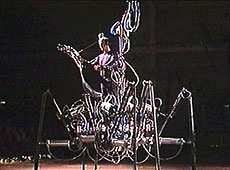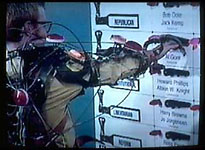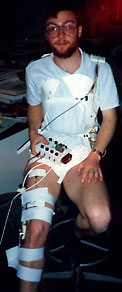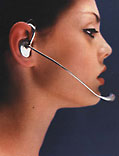Future Bodies
 To
draw attention to the real future of cybernetics, it is not sufficient
to create machines that simply attach to the body. We believe the two
must be integrated in a natural and synergistic way. We live in a fashion
conscious culture and it is unlikely that wearable machines of the future
will be of the cumbersome type that has been seen from many "cyborg artists".
Stelarc's Exoskeleton project, for instance, posseses all the trappings
of cybernetics and certainly extends his physical vehicle, but it is not
the kind of apparatus anyone would want to walk around in everyday.
To
draw attention to the real future of cybernetics, it is not sufficient
to create machines that simply attach to the body. We believe the two
must be integrated in a natural and synergistic way. We live in a fashion
conscious culture and it is unlikely that wearable machines of the future
will be of the cumbersome type that has been seen from many "cyborg artists".
Stelarc's Exoskeleton project, for instance, posseses all the trappings
of cybernetics and certainly extends his physical vehicle, but it is not
the kind of apparatus anyone would want to walk around in everyday.  The
Center For Metahuman Exploration has created some fantastic cybernetic
devices for Absentee Ballot and others similar projects, but again
these are cumbersome devices, exhibiting a standard mechanical geometry
in their visual aesthetics.
The
Center For Metahuman Exploration has created some fantastic cybernetic
devices for Absentee Ballot and others similar projects, but again
these are cumbersome devices, exhibiting a standard mechanical geometry
in their visual aesthetics.
Instead, cybernetics will likely be worn as decorative elements, expressing individual tastes, much like watches, sunglasses, and pagers today. For example, consider the progress of cell phones, how ubiquitous they've become, and how personalized and integrated into our fashion styles they've become.
The body modification community has already begun extending the definition
of the body by pushing the boundaries of expected body forms. The new
field of implant modifications, pioneered by Steve Haworth, is allowing
individuals to aesthetically reshape their bodies in unexpected ways.
Jesse has been deeply involved with Steve in new experiments with custom
carved implant forms in silicone and teflon, allowing people to express
alien body forms.
 |
 |
 |
 |
 |
 |
 |
 |

 How
long will it be before such implants have technological functionality
as well? Externally worn cybernetic units have already begun to appear
on the consumer market, and work such as Warwick's allows for the implantation
of passive, unpowered transmission technologies. The real problem with
high function, implanted cybernetics is the power supply. Anything battery
driven would require surgery every time the battery needed replaced. Running
power lines from an external source into the skin opens too many risks
for infection. However, research into transcutaneous electrical transfer
(the use of an implanted inductance coil and an external coil to pass
a current through the skin without an opening) brings imbedded cybernetics
closer to reality.Such systems are already being used in some electrical
stimulation units designed to give paraplegic individuals rudimentary
standing and walking capabilities.
How
long will it be before such implants have technological functionality
as well? Externally worn cybernetic units have already begun to appear
on the consumer market, and work such as Warwick's allows for the implantation
of passive, unpowered transmission technologies. The real problem with
high function, implanted cybernetics is the power supply. Anything battery
driven would require surgery every time the battery needed replaced. Running
power lines from an external source into the skin opens too many risks
for infection. However, research into transcutaneous electrical transfer
(the use of an implanted inductance coil and an external coil to pass
a current through the skin without an opening) brings imbedded cybernetics
closer to reality.Such systems are already being used in some electrical
stimulation units designed to give paraplegic individuals rudimentary
standing and walking capabilities.
Embedded "normalizing" cybernetics is becoming more widespread,
for example prosthetic limbs controlled via electromyography. Body modification
pioneers may likely be the first group to extensively integrate enhancing,
augmenting cybernetic functionality underneath the skin. I think the future
of cybernetic modifications will likely be accepted by mainstream culture
much more quickly than aesthetic modifications have, simply because they
do have practical purposes. People in this culture love their useful tech
gadgets. Also, by the time the technologies are stable enough for commercial
internalized cybernetics, going under the skin might have a much wider
acceptance because of the work in aesthetic modifications that's happening
now. The transition from miniature wearables to implantables might be
really subtle, too subtle for most people to bother making a distinction.
Two years ago I had the opportunity to try on a prototype micro-mini display that clips to eye glasses, developed at
MIT. This is a more recent version using a reflector surface on the lens.
These displays work in conjunction with clip on wearable processors &
chording keyboards. A recent TV commercial, showing a day trader in a
park shouting "buy! buy! sell!" as her operates his almost invisible wearable
computer, suggests that products such as this will very soon be available
to the consumer. The next step might be something you put in like a contact
lens. What's the leap from there to a display implanted under the cornea?
Who here sees a distinction? For those of you who raised your hand, how
many also make a distinction between contact lenses and vision correcting
laser eye surgery?
a prototype micro-mini display that clips to eye glasses, developed at
MIT. This is a more recent version using a reflector surface on the lens.
These displays work in conjunction with clip on wearable processors &
chording keyboards. A recent TV commercial, showing a day trader in a
park shouting "buy! buy! sell!" as her operates his almost invisible wearable
computer, suggests that products such as this will very soon be available
to the consumer. The next step might be something you put in like a contact
lens. What's the leap from there to a display implanted under the cornea?
Who here sees a distinction? For those of you who raised your hand, how
many also make a distinction between contact lenses and vision correcting
laser eye surgery?
Transforming Boundaries |
